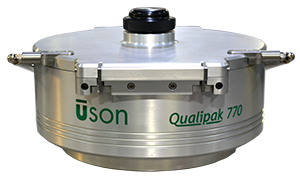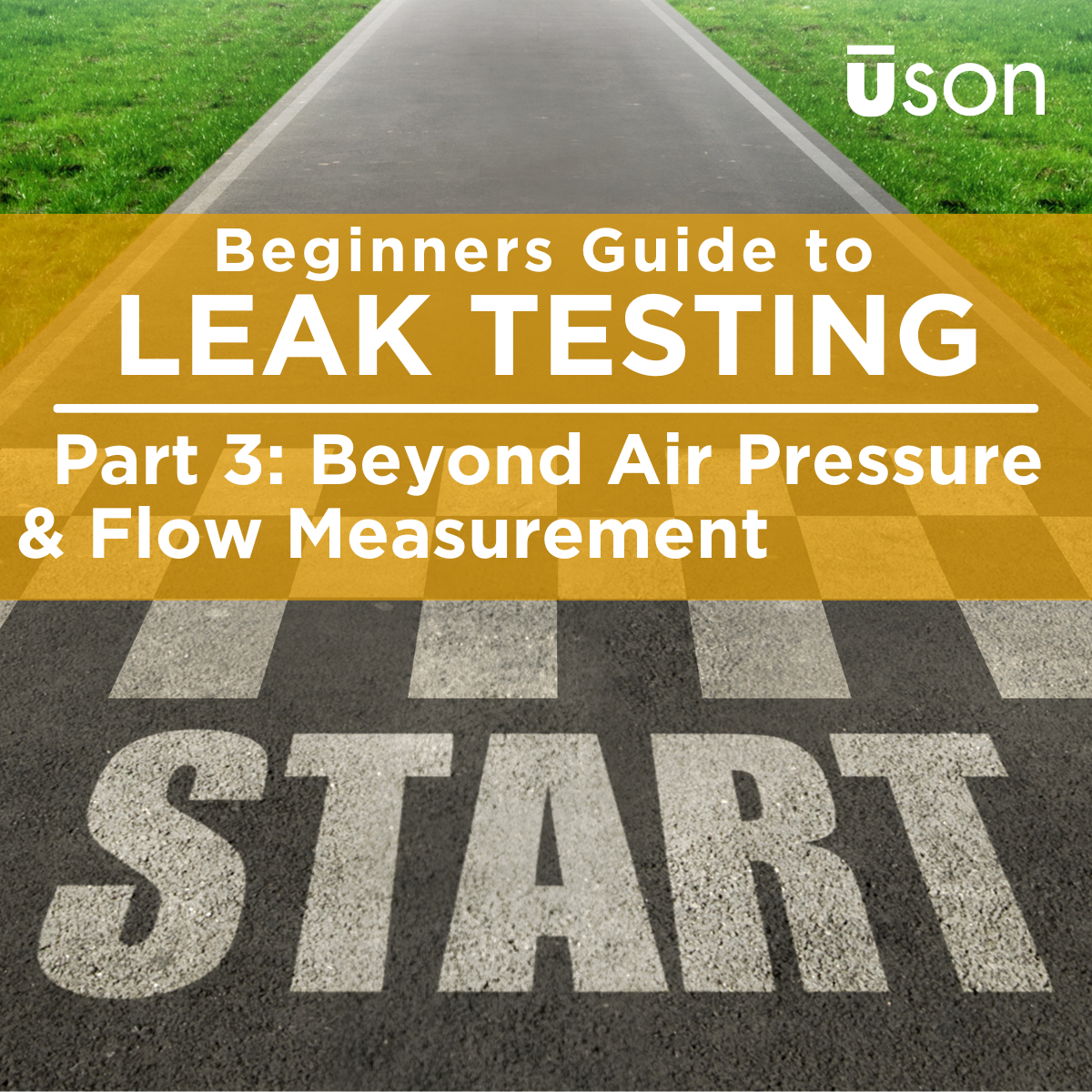The Beginner’s Guide to Leak Testing – Part 5: How to Select the Best Instrument for Your Needs
Uson guides you through choosing the best leak tester. Whether you're performing simple leak tests, complex multi-step processes, or flow and burst...
Continuing our series in Part 3, we delve into alternative leak test methods that go beyond air pressure or flow measurement. We begin by exploring trace or tracer gas leak detection methods, followed by a closer look at some lesser-known specialized techniques for leak detection.
Trace gas leak detection methods are used to detect and measure the flow of a specified gas as it moves through the test part. The ideal gas will have small molecules so that it can pass through the smallest holes or leak paths and be absent from the surrounding atmosphere to make detection easier. Two gases that meet these requirements are helium and hydrogen. Of course, the accumulation of hydrogen in any kind of confined space is a safety issue so in order to use it safely it is supplied as diluted 5% hydrogen in nitrogen mixture.
There are various methods of using trace gas and this makes it a versatile technique:
One of the virtues of using a trace gas is that, unlike air decay or mass flow measurement, it enables us to locate the leak site. By pressurizing a part with the trace gas and then using a device with a probe and suitable detector to “sniff” around the likely leak sites we can find exactly where the leak is occurring. For certain applications this is a huge benefit. While many rejects of the air leak test are simply discarded or sent for recycling, some items can be adjusted and tested again for example, valves, gas burners, faucets and expensive items such as car and truck engines.
Alas, nothing is perfect, and the trace gas sniffing technique is slow and difficult to automate. However, it does make an extremely good partner with air decay testing. Combining the speed of the air decay test to identify the leaking parts and the trace gas sniffer to locate the leaks can enable manufacturers to recover rejected assemblies and save time on rework.
The mass spectrometer is a complex piece of equipment that detects helium trace gas at very low concentrations and thus compute very small leak rates. It is widely acknowledged as the most sensitive leak test method currently on the market. Gas entering the mass spectrometer is ionized and flows through a tube placed in a magnetic field. Ions which are heavier or lighter than helium will be pulled one way or another out of the path of the detector. Helium ions arriving at the detector generate an electrical signal that is in proportion to the amount of helium present and thus the leak rate can be calculated. In practice there are two common methods of using the mass spectrometer.
(A) The part is pressurized with helium and placed in a vacuum chamber. A hard vacuum is created on the outside of the part and any escaping helium is carried to the mass spectrometer which is placed between the vacuum source and the chamber.
(B) The part is connected to the vacuum line and placed inside a chamber which is filled with helium. If there isa leak in the part the helium will be pulled into that part and carried to the mass spectrometer.
In instances where it is not possible to connect either the vacuum source or the helium source to the part a technique known as “bombing” maybe used. A sealed part is subjected to pressurized helium in a leak tight container for an extended period (several minutes) and it is effectively bombarded by helium. When the “bombing” is complete the chamber is purged and evacuated. Any helium that was forced into the part under pressure escapes through the path of entry and is carried to the mass spectrometer detector.
The above is intended only as a brief overview of the principle of mass spectrometry as a leak detection technique. The correct selection of the equipment, sizing of the vacuum pumps and chambers and assembly of the system is a subject worthy of far more detail than the intention behind this blog allows.
Helium as trace gas is not a perfect answer. It is a finite resource and is difficult to recover. Once it escapes into our atmosphere it is lost forever. It is therefore costly and only likely to increase in price. For more information on helium leak testing visit Air Leak Testing vs Helium Leak Testing.
In theory any gas can be used as a trace gas providing that it can yield a suitable detector response. A whole industry exists around the detection of HFC (hydrofluorocarbon) and CFC (chlorofluorocarbon) compounds used as refrigerants. Their chemical structure makes them ideal for detection with electron capture detectors. Of course, they are totally unacceptable for use as trace gases and their molecular size is large compared to helium or hydrogen. Some trace gas detectors use a thermal conductivity detector. This type of detector can detect any gas that has a thermal conductivity different to air. The actual sensitivity of the detector depends upon the gas that has been chosen for detection.
After methods based around the measurement of air pressure and flow, trace gas techniques are the second most popular. Let’s conclude part 3 by looking at some less common specialized leak detection methods.
Force decay measurement is an interesting technique that has a niche in the detection of leaks in flexible packaging. Traditionally the most common methods of testing flexible packaging for leaks are to look for bubbles of air or gas escaping from the package as it is held under water. To facilitate the process, the pack is subjected to internal pressurization either by the insertion of a needle through which air is introduced or with the creation of a pressure differential by placing the pack underwater in a vacuum chamber. Both of these methods cause the pack to expand. These methods can be messy, subjective and destructive.
 The Uson Qualipak instruments, such as the Uson Qualipak 770 shown here, non-destructively measure the force generated as the pack expands under vacuum by restricting the package beneath a fixed surface and directing the force of expansion to another surface that is connected to a load cell or strain gauge. As the vacuum level increases, the force generated increases. When the vacuum source is turned off and the vacuum chamber is isolated, the force exerted on the load cell should remain steady. If a leak exists, the pressure will decrease or decay as the air or gas inside the pack escapes. Packs which exhibit decay rates higher than limits determined to be acceptable are rejected. Those that have gross leaks will fail to reach a pre-determined minimum force level and will be rejected during the evacuation of the chamber.
The Uson Qualipak instruments, such as the Uson Qualipak 770 shown here, non-destructively measure the force generated as the pack expands under vacuum by restricting the package beneath a fixed surface and directing the force of expansion to another surface that is connected to a load cell or strain gauge. As the vacuum level increases, the force generated increases. When the vacuum source is turned off and the vacuum chamber is isolated, the force exerted on the load cell should remain steady. If a leak exists, the pressure will decrease or decay as the air or gas inside the pack escapes. Packs which exhibit decay rates higher than limits determined to be acceptable are rejected. Those that have gross leaks will fail to reach a pre-determined minimum force level and will be rejected during the evacuation of the chamber.
Measuring the force decay in this way provides a non-destructive and non-subjective method of detecting leaks in flexible packaging.
Escaping air or gas creates turbulence and high frequency noise, frequently inaudible to the human ear (think of the high-pitched dog whistle). An ultrasonic detector is able to “hear” that high frequency noise. Thus, if a part or often a system can be pressurized with air or gas, even at a relatively low pressure, the ultra-sonic detector maybe used to locate the source of the high frequency noise caused by the turbulent escape of the air or gas.
This technique can be useful for finding leaks in large volumes such as fuel tanks and compressed air systems found in factories. In very large volumes it may be necessary to place and ultrasonic transmitter inside the space. Moving the detector around the likely leak paths will reveal high frequency noise at the leak site. This method has been used with success to check the leak tightness of automobile windshields, aircraft windows and even the fuel tanks in aircraft wings.
Process plants have many thousands of potential leak sites and must have a Leak Detection and Remediation (LDAR) plan if they are processing volatile chemicals. Using the thermal imaging technology of a special forward looking infra-red camera, operators can see where the leak or leaks are due to small temperature differences caused at the leak site by escaping chemicals. This technique is useful in this type of application where high sensitivity is not an issue and leaks tend to be large by leak detection standards.
In the next installment we will look at the features of the most common leak detector, the pressure decay instrument.
Stay tuned for upcoming posts in our The Beginners Guide to Leak Testing series:
Want more leak testing basics? You can find a plethora of resources right here at Uson.com. Check out our Blog and Resources section for educational articles, test method library, videos and more.
If you're a beginner at leak testing (or know just enough to be dangerous) and need expert help identifying the right test method, process and leak tester for your application, the experts at Uson can help. Uson has helped thousands of product manufacturers around the world with their toughest application challenges for 60 years. We can help you too. Contact us today!
Uson guides you through choosing the best leak tester. Whether you're performing simple leak tests, complex multi-step processes, or flow and burst...
Explore the features of the Qualitek mR, a top-performing leak testing system designed for rapid and accurate leak detection. See why it stands out...
In Part 2 of The Beginners Guide to Leak Testing we delve into the fundamental techniques of leak testing using air as the testing medium.
Industries
